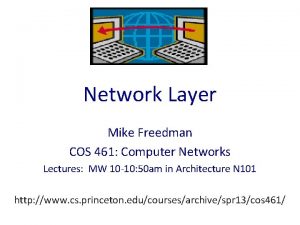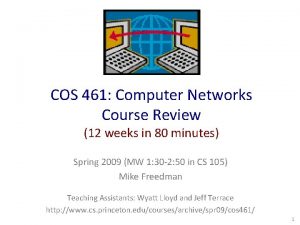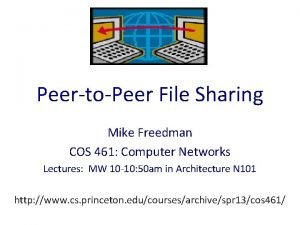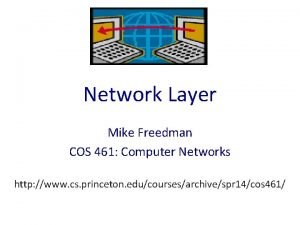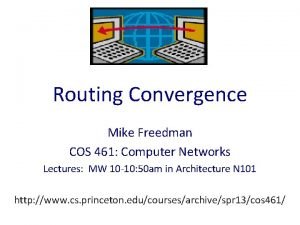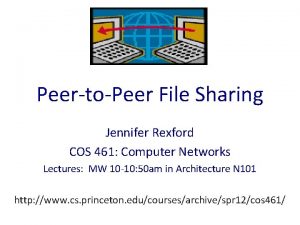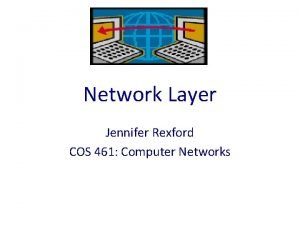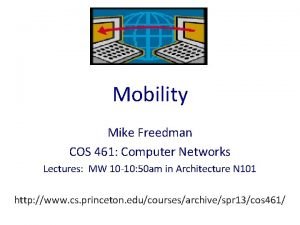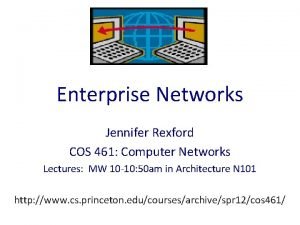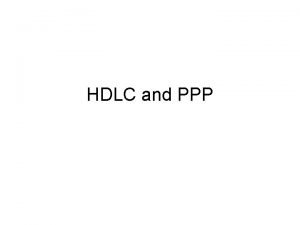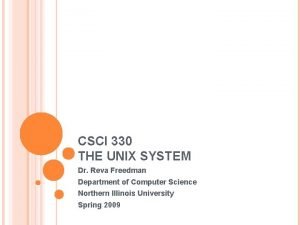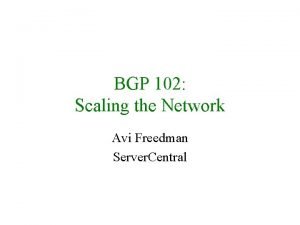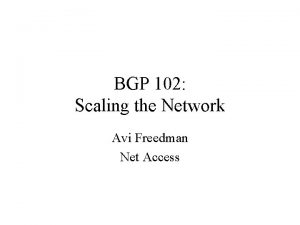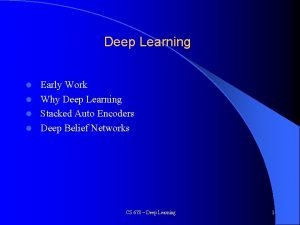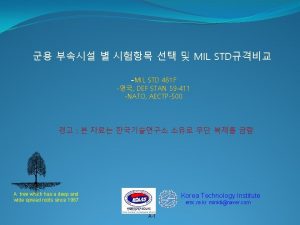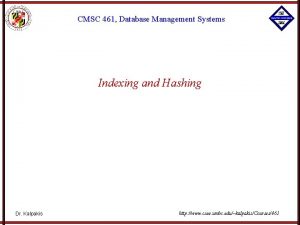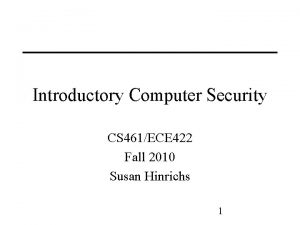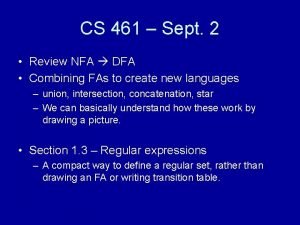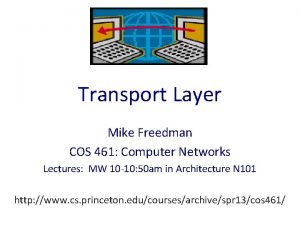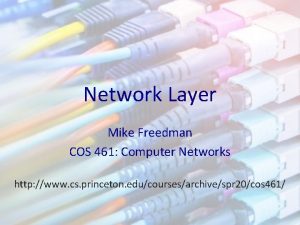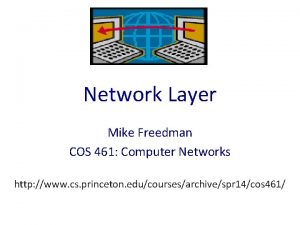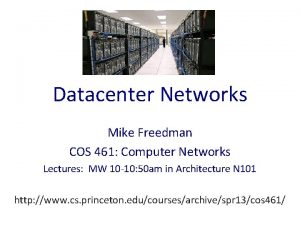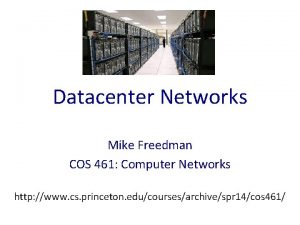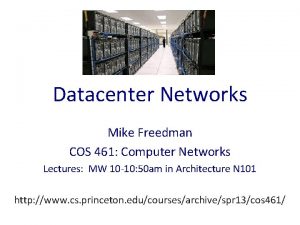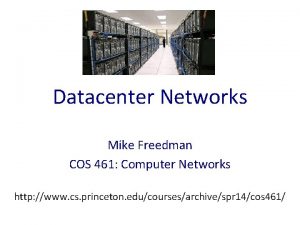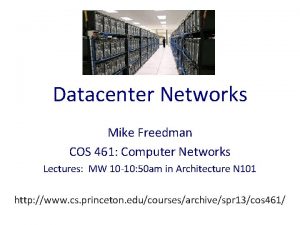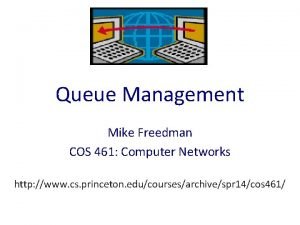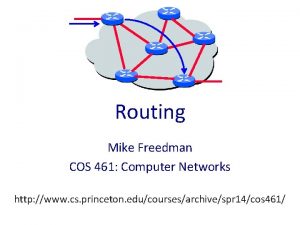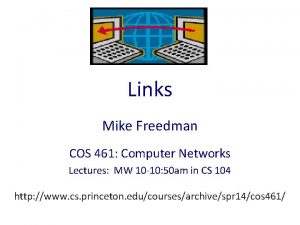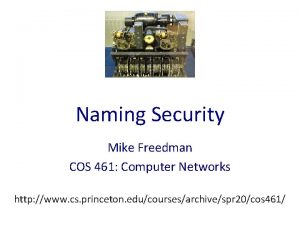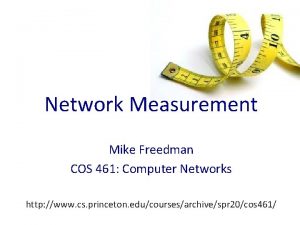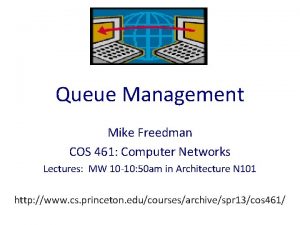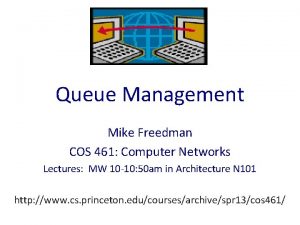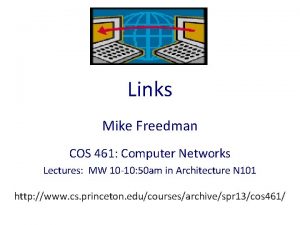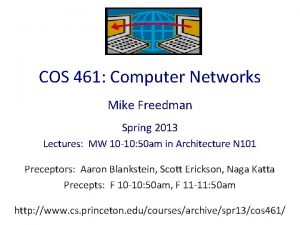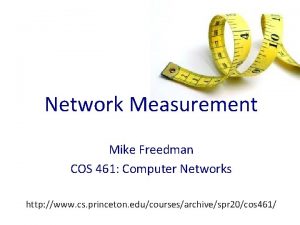Transport Layer Mike Freedman COS 461 Computer Networks








































- Slides: 40

Transport Layer Mike Freedman COS 461: Computer Networks Lectures: MW 10 -10: 50 am in Architecture N 101 http: //www. cs. princeton. edu/courses/archive/spr 13/cos 461/

IP Protocol Stack: Key Abstractions Application Transport Network Link Applications Reliable streams Messages Best-effort global packet delivery Best-effort local packet delivery • Transport layer is where we “pay the piper” – Provide applications with good abstractions – Without support or feedback from the network 2

Transport Protocols • Logical communication between processes – Sender divides a message into segments – Receiver reassembles segments into message • Transport services – (De)multiplexing packets – Detecting corrupted data – Optionally: reliable delivery, flow control, … 3

Two Basic Transport Features • Demultiplexing: port numbers Server host 128. 2. 194. 242 Client host Service request for 128. 2. 194. 242: 80 (i. e. , the Web server) Client Web server (port 80) OS Echo server (port 7) • Error detection: checksums IP payload detect corruption 4

User Datagram Protocol (UDP) • Lightweight communication between processes – Send and receive messages – Avoid overhead of ordered, reliable delivery 8 byte header SRC port DST port checksum length DATA • No connection setup delay, no in-kernel connection state • Used by popular apps – Query/response for DNS – Real-time data in Vo. IP 5

Transmission Control Protocol (TCP) • Stream-of-bytes service – Sends and receives a stream of bytes • Connection oriented – Explicit set-up and teardown of TCP connection • Reliable, in-order delivery • Flow control – Corruption: checksums – Detect loss/reordering: sequence numbers – Reliable delivery: acknowledgments and retransmissions – Prevent overflow of the receiver’s buffer space • Congestion control – Adapt to network congestion for the greater good 7

Breaking a Stream of Bytes into TCP Segments 8

TCP “Stream of Bytes” Service Host A Byte 80 Byte 3 Byte 2 Byte 1 Byte 0 Host B Byte 80 Byte 3 Byte 2 Byte 1 Byte 0 9

…Emulated Using TCP “Segments” Host A Byte 80 Byte 3 Byte 2 Byte 1 Byte 0 Segment sent when: 1. Segment full (Max Segment Size), 2. Not full, but times out, or 3. “Pushed” by application TCP Data Host B TCP Data Byte 80 Byte 3 Byte 2 Byte 1 Byte 0 10

TCP Segment • IP packet IP Data TCP Data (segment) TCP Hdr IP Hdr – No bigger than Maximum Transmission Unit (MTU) – E. g. , up to 1500 bytes on an Ethernet link • TCP packet – IP packet with a TCP header and data inside – TCP header is typically 20 bytes long • TCP segment – No more than Maximum Segment Size (MSS) bytes – E. g. , up to 1460 consecutive bytes from the stream 11

Sequence Number Host A ISN (initial sequence number) Byte 81 Sequence number = 1 st byte Host B TCP Data 12

Reliable Delivery on a Lossy Channel With Bit Errors 14

Challenges of Reliable Data Transfer • Over a perfectly reliable channel: Done • Over a channel with bit errors – Receiver detects errors and requests retransmission • Over a lossy channel with bit errors – Some data missing, others corrupted – Receiver cannot easily detect loss • Over a channel that may reorder packets – Receiver cannot easily distinguish loss vs. out-of-order 15

An Analogy • Alice and Bob are talking – What if Alice couldn’t understand Bob? – Bob asks Alice to repeat what she said • What if Bob hasn’t heard Alice for a while? – Is Alice just being quiet? Has she lost reception? – How long should Bob just keep on talking? – Maybe Alice should periodically say “uh huh” – … or Bob should ask “Can you hear me now? ” 16

Take-Aways from the Example • Acknowledgments from receiver – Positive: “okay” or “uh huh” or “ACK” – Negative: “please repeat that” or “NACK” • Retransmission by the sender – After not receiving an “ACK” – After receiving a “NACK” • Timeout by the sender (“stop and wait”) – Don’t wait forever without some acknowledgment 17

TCP Support for Reliable Delivery • Detect bit errors: checksum – – • Detect missing data: sequence number – – • Used to detect corrupted data at the receiver …leading the receiver to drop the packet Used to detect a gap in the stream of bytes. . . and for putting the data back in order Recover from lost data: retransmission – – Sender retransmits lost or corrupted data Two main ways to detect lost packets 18

TCP Acknowledgments Host A ISN (initial sequence number) Sequence number = 1 st byte Host B TCP Data ACK sequence number = next expected byte TCP Data 19

Automatic Repeat re. Quest (ARQ) • ACK and timeouts – Receiver sends ACK when it receives packet – Sender waits for ACK and times out Timeout Sender Receiver Packe t ACK • Simplest ARQ protocol – Stop and wait – Send a packet, stop and wait until ACK arrives Time 20

Quick TCP Math • Initial Seq No = 501. Sender sends 4500 bytes successfully acknowledged. Next sequence number to send is: (A) 4501 (B) 5000 (C) 5001 (D) 5002 • Next 1000 byte TCP segment received. Receiver acknowledges with ACK number: (A) 5001 (B) 6000 (C) 6001 21

Flow Control: TCP Sliding Window 23

Motivation for Sliding Window • Stop-and-wait is inefficient – Only one TCP segment is “in flight” at a time • Consider: 1. 5 Mbps link with 50 ms round-trip-time (RTT) – Assume segment size of 1 KB (8 Kbits) – 8 Kbits/segment at 50 msec/segment 160 Kbps – That’s 11% of the capacity of 1. 5 Mbps link 24

Sliding Window • Allow a larger amount of data “in flight” – Allow sender to get ahead of the receiver – … though not too far ahead Sending process TCP Last byte written Last byte ACKed Last byte sent Receiving process TCP Last byte read Next byte expected Last byte received 25

Receiver Buffering • Receive window size – Amount that can be sent without acknowledgment – Receiver must be able to store this amount of data • Receiver tells the sender the window – Tells the sender the amount of free space left Window Size Data ACK’d Outstanding Un-ack’d data Data OK to send Data not OK to send yet 26

Optimizing Retransmissions 27

Packe t ACK Packet lost ACK Packe t ACK lost DUPLICATE PACKET Timeout Packe t Timeout Packe Timeout Reasons for Retransmission Packe t K C A Packe t ACK Early timeout DUPLICATE PACKETS 28

How Long Should Sender Wait? • Sender sets a timeout to wait for an ACK – Too short: wasted retransmissions – Too long: excessive delays when packet lost • TCP sets timeout as a function of the RTT – Expect ACK to arrive after an “round-trip time” – … plus a fudge factor to account for queuing • But, how does the sender know the RTT? – Running average of delay to receive an ACK 29

Still, timeouts are slow (≈RTT) • When packet n is lost… – … packets n+1, n+2, and so on may get through • Exploit the ACKs of these packets – ACK says receiver is still awaiting nth packet – Duplicate ACKs suggest later packets arrived – Sender uses “duplicate ACKs” as a hint • Fast retransmission – Retransmit after “triple duplicate ACK” 31

Effectiveness of Fast Retransmit • When does Fast Retransmit work best? – High likelihood of many packets in flight – Long data transfers, large window size, … • Implications for Web traffic – Most Web transfers are short (e. g. , 10 packets) • So, often there aren’t many packets in flight – Making fast retransmit is less likely to “kick in” • Forcing users to click “reload” more often… 32

Effectiveness of Fast Retransmit • When does Fast Retransmit work best? (A) Short data transfers (B) Large window size (C) Small RTT networks 33

Effectiveness of Fast Retransmit • When does Fast Retransmit work best? (A) Short data transfers (B) Large window size (C) Small RTT networks • Implications for Web traffic – Most Web transfers are short (e. g. , 10 packets) • So, often there aren’t many packets in flight – Making fast retransmit is less likely to “kick in” • Forcing users to click “reload” more often… 34

Starting and Ending a Connection: TCP Handshakes 35

Establishing a TCP Connection A SYN CK SYN A ACK Data B Each host tells its ISN to the other host. • Three-way handshake to establish connection – Host A sends a SYN (open) to the host B – Host B returns a SYN acknowledgment (SYN ACK) – Host A sends an ACK to acknowledge the SYN ACK 36

TCP Header Source port Destination port Sequence number Flags: SYN FIN RST PSH URG ACK Acknowledgment Hdr. Len 0 Flags Advertised window Checksum Urgent pointer Options (variable) Data 37

Step 1: A’s Initial SYN Packet A’s port B’s port A’s Initial Sequence Number Flags: SYN FIN RST PSH URG ACK Acknowledgment 20 Flags 0 Checksum Advertised window Urgent pointer Options (variable) A tells B it wants to open a connection… 38

Step 2: B’s SYN-ACK Packet B’s port A’s port B’s Initial Sequence Number Flags: SYN FIN RST PSH URG ACK A’s ISN plus 1 20 Flags 0 Checksum Advertised window Urgent pointer Options (variable) B tells A it accepts, and is ready to hear the next byte… … upon receiving this packet, A can start sending data 39

Step 3: A’s ACK of the SYN-ACK A’s port B’s port Sequence number Flags: SYN FIN RST PSH URG ACK B’s ISN plus 1 20 Flags 0 Checksum Advertised window Urgent pointer Options (variable) A tells B it is okay to start sending … upon receiving this packet, B can start sending data 40

SYN Loss and Web Downloads • Upon sending SYN, sender sets a timer – If SYN lost, timer expires before SYN-ACK received – Sender retransmits SYN • How should the TCP sender set the timer? – No idea how far away the receiver is – Some TCPs use default of 3 or 6 seconds • Implications for web download – User gets impatient and hits reload – … Users aborts connection, initiates new socket – Essentially, forces a fast send of a new SYN! 41

Tearing Down the Connection ACK FIN Data ACK FIN ACK CK A SYN B time • Closing (each end of) the connection – Finish (FIN) to close and receive remaining bytes – And other host sends a FIN ACK to acknowledge – Reset (RST) to close and not receive remaining bytes 42

Sending/Receiving the FIN Packet • Sending a FIN: close() • Receiving a FIN: EOF – Process is done sending data via socket – Process is reading data from socket – Process invokes “close()” – Eventually, read call returns an EOF – Once TCP has sent all the outstanding bytes… – … then TCP sends a FIN 43

Conclusions • Transport protocols – Multiplexing and demultiplexing – Checksum-based error detection – Sequence numbers – Retransmission – Window-based flow control • Precept on Friday – Application-layer protocols: HTTP – HTTP proxy assignment 44
 Secure socket layer and transport layer security
Secure socket layer and transport layer security Secure socket layer and transport layer security
Secure socket layer and transport layer security Secure socket layer and transport layer security
Secure socket layer and transport layer security Secure socket layer and transport layer security
Secure socket layer and transport layer security Cos 461
Cos 461 Cos 461
Cos 461 Cos 461
Cos 461 Cos 461
Cos 461 Cos 461
Cos 461 Cos 461
Cos 461 Cos 461
Cos 461 Cos 461
Cos 461 Precidr
Precidr Cos
Cos Cos 461
Cos 461 A switch in a datagram network uses
A switch in a datagram network uses Basestore iptv
Basestore iptv Data link layer switching in computer networks
Data link layer switching in computer networks Osi modeli
Osi modeli Comparison of virtual circuit and datagram subnets
Comparison of virtual circuit and datagram subnets Utopian simplex protocol
Utopian simplex protocol Hdlc categories
Hdlc categories Design issues of network layer
Design issues of network layer Internet transport protocol in computer networks
Internet transport protocol in computer networks Young and freedman
Young and freedman Current resistance and electromotive force
Current resistance and electromotive force Capacitncia
Capacitncia Danielle freedman
Danielle freedman Rabbi david freedman
Rabbi david freedman Neil freedman
Neil freedman Steve freedman
Steve freedman Jerome freedman
Jerome freedman Csci 330
Csci 330 Avi freedman net worth
Avi freedman net worth Avi freedman net worth
Avi freedman net worth A link layer protocol for quantum networks
A link layer protocol for quantum networks Greedy layer wise training of deep networks
Greedy layer wise training of deep networks Mil std 461 rs103
Mil std 461 rs103 Cmsc 461
Cmsc 461 Uiuc cs 461
Uiuc cs 461 Cs 461
Cs 461





